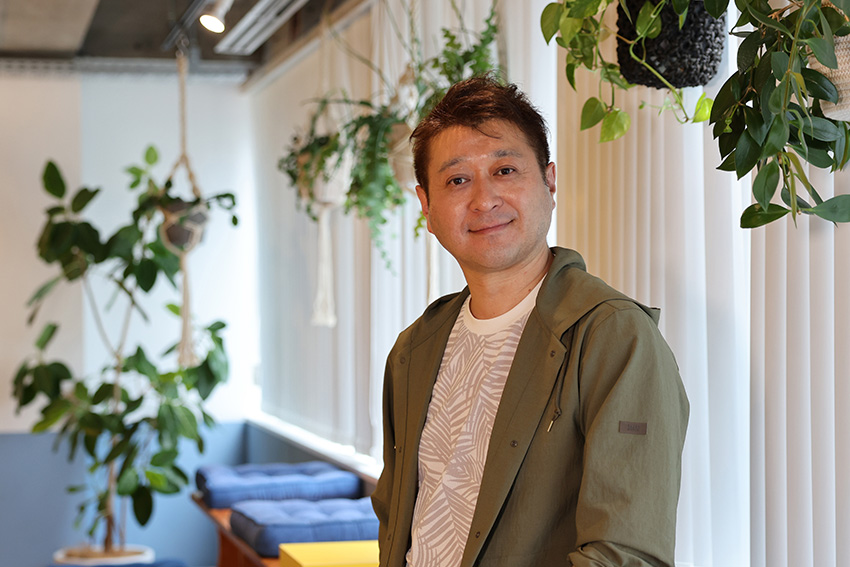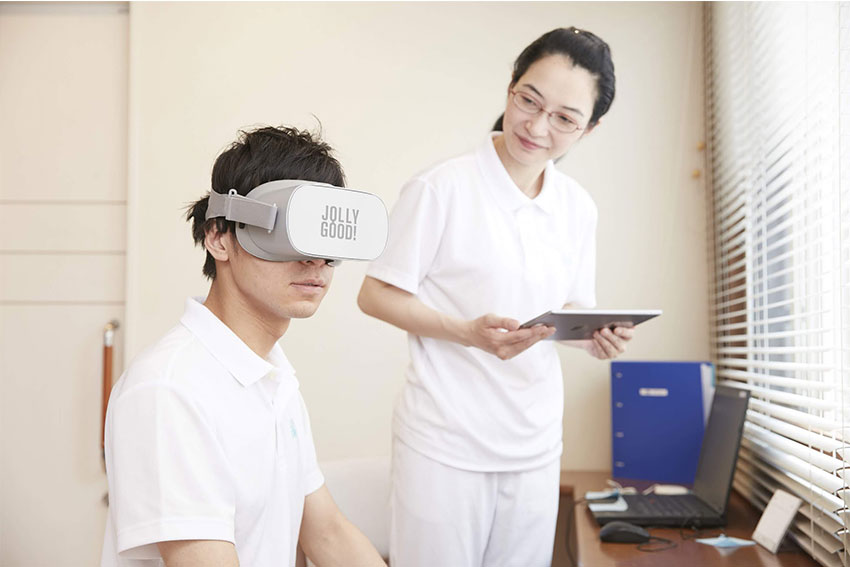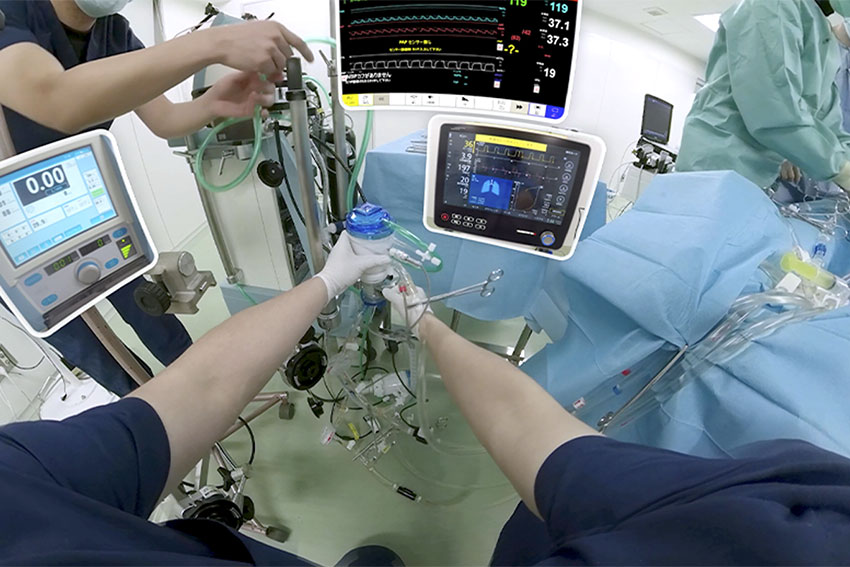In this interview, Jolly Good tells us how it collaborates to identify global challenges and develop innovative technology solutions

One of the significant challenges facing Japanese society is its demographic decline. With the oldest population in the world, Japan is grappling with the many difficulties posed by an aging society. Among these challenges is cognitive decline, an issue your company is addressing through the FACEDUO Dementia Care Support VR. This innovative software helps carers and families of dementia patients better understand their behavior. Could you start by introducing this software and explain how companies like yours can contribute to addressing the broader challenges of an aging population in Japan?
We have introduced a training program specifically designed for families of dementia patients, who are referred to as carers in Japan. The program aims to help carers understand the unique behavioral patterns and communication styles of dementia patients, which differ significantly from those of others. For instance, dementia patients often pause during conversations. Through this program, we enable carers to experience and better comprehend these communication challenges firsthand.
In addition to this, we offer similar services for patients with other symptoms. Our primary goal is to support carers and empower them to play an active role in the care and treatment of patients. Currently, we are also developing a rehabilitation program for dementia patients. However, due to a non-disclosure agreement, I am unable to share further details at this time.

Japan is not alone in facing demographic decline. Many other countries, including Korea and China, as well as European nations like Germany, are dealing with similar challenges. Looking ahead, are there specific countries where you hope to introduce your programs in the future?
We have received numerous offers from countries such as the US, Thailand, and China to develop VR programs. These countries view Japan’s nursing technology and hospice care techniques as some of the highest quality in the world. They are particularly interested in offering these VR programs to affluent members of their societies. As Japan is a highly aged society, they recognize the advanced nature of our care systems.
We have already entered the US market and have received offers to develop VR nursing care programs. While we’ve successfully developed these programs in Japan, the current challenge lies in establishing a distribution framework in the US. At the moment, we are working on creating the necessary infrastructure for this.
I firmly believe that providing VR nursing care services to other countries is a responsibility that Japanese companies should embrace.
Over the past decade, there has been significant discussion around VR and its associated technologies, including the Metaverse. For example, Facebook integrated it heavily into its branding and communication strategy. However, the reality is that the technology has yet to deliver the widespread impact many had envisioned. While it is being used effectively in entertainment and gaming, its broader adoption across industrial sectors remains limited. In your view, which sectors are best positioned to adopt VR on a deeper level, and how long do you think it will take for this technology to achieve broader utilization across various industries?
I believe the professional job training sector is well-positioned to adopt VR. Before COVID-19, we developed professional training VR programs for industries such as manufacturing, construction, restaurants, and daycare. At that time, the medical field was just one of the industries we served. However, when the pandemic hit, the medical field became our sole focus. That shift led us to concentrate on the medical and nursing fields.
Since the pandemic ended, we have resumed developing programs for the manufacturing and logistics industries, as well as for Japanese restaurants. In the case of Japanese restaurants, both domestic and international owners are recognizing the growing global interest in Japanese cuisine. Many are planning to establish Japanese restaurants worldwide and have specifically requested VR programs to teach the preparation of Japanese dishes.
Our mission as a company is to develop these VR training programs and distribute them globally, supporting industries while preserving and sharing Japanese culinary culture.
Many Japanese industries excel in automating their processes. However, Japan has faced criticism for its relatively slow adoption of digital tools in everyday business operations. This was reflected in the latest digital competitiveness rankings, where Japan placed 28th. As a company offering high-tech services in the medical field and other areas you’ve mentioned, what do you identify as the biggest challenges in adopting these technologies within Japan, and how are you working to overcome them?
Japanese people tend to be quite conservative, often preferring to maintain the status quo rather than embrace change. This mindset is the biggest obstacle and a key reason why Japanese companies lag in adopting digital tools.
Taking this traditional mindset into account, what are some of the case studies you show to convince potential clients to adopt your VR training programs?
There are many approaches to addressing this issue, but I believe two, in particular, are highly effective. The first is to collaborate with large companies or groups to create high-profile, large-scale demonstration cases. The second is to establish a proven track record abroad and then bring those successes back to Japan. By showcasing how Japanese technologies have been accepted and implemented internationally, we can persuade domestic clients to adopt them.
This strategy, which we refer to as the "mirror effect," involves leveraging the strong reputation of our products overseas to build trust and credibility with clients in Japan. For example, we’ve been actively sharing our VR technology in markets like Southeast Asia and the US to demonstrate its value and encourage adoption back home.
With the growing use of VR, its benefits—such as enhancing skill development without requiring physical attendance—are clear. However, critics have raised valid concerns about the potential erosion of real-world social interactions due to the increasing reliance on digital tools. How do you respond to these concerns, and what steps is your company taking to address them? What would you say to those who voice these criticisms?
While we provide job training using VR, we do not believe that everything will or should be replaced by VR, nor that all activities should take place in virtual spaces. It’s crucial to distinguish and identify the areas where VR is most effective. For example, in job training, VR serves as a valuable tool for practice prior to hands-on training.
VR technology is also being utilized in fields such as tourism, but this approach can be divisive, as many people still prefer in-person experiences. We are very mindful of these preferences and do not advocate for an all-encompassing use of VR. Instead, we are highly selective about where and how we introduce VR, ensuring it is applied only in areas where it truly adds value.
Your company was founded in 2014 and has since established itself as a pioneer in the VR field. Could you share with our readers some of the key milestones in your company’s journey so far? Additionally, could you highlight a project that you are particularly proud of as a case study?
Looking back on our corporate history, I believe one of the most significant milestones was the VR training we provided for medical practitioners during the COVID-19 pandemic, particularly for those treating patients with severe symptoms. Have you heard of ECMO? It stands for Extracorporeal Membrane Oxygenation, a procedure that uses a machine to support a patient’s lungs and heart. When the pandemic began, there were 2,000 ECMO machines available in Japan, but only around 200 medical practitioners were trained to operate them.
At that critical time, the Japanese government approached us to develop VR training content to address this shortage. After creating the necessary materials, we organized training programs across Japan, with sessions attended by up to 100 participants at a time. Each participant wore VR goggles and underwent simultaneous training. As a result, we significantly increased the number of medical practitioners capable of handling ECMO, which directly contributed to saving many lives during the pandemic.
This initiative was an important milestone for us, not only because of its impact on healthcare but also for the recognition it brought to our company. The seminars, featuring participants wearing VR goggles, were covered extensively by nearly all major TV stations in Japan. The memorable images of doctors engaged in VR training greatly increased public awareness of our work. This project is something we are particularly proud of, as it exemplifies the potential of VR to solve real-world challenges and make a meaningful difference.

One of your current initiatives is your partnership with Teijin Pharma to launch VR DTx as you expand into the psychotherapy field. We understand that you’re set to begin clinical trials this year to assess its efficacy and safety. How are these trials progressing, and how do you see this technology being integrated into mainstream mental health care in the future?
The National Center of Neurology and Psychiatry (NCNP) approached us with a request to develop VR for Cognitive Behavioral Therapy (CBT). Initially, we were unfamiliar with CBT, but through our research, we discovered that it involves one-hour interviews between a patient and a psychiatrist, conducted over a 16-week period. This process places a heavy burden on psychiatrists, as typical doctor-patient consultations usually last only 3-5 minutes. As a result, CBT sessions, despite being highly effective, were rarely implemented due to their time-intensive nature.
To address this challenge, we developed a VR program for patients. Through this program, patients receive counselling sessions with a virtual doctor, creating the experience of an actual interview within a virtual space. This innovation significantly reduced the time required for one CBT session from the original duration. The final session still involves the actual psychiatrist, but because most of the consultation has been conducted via VR, the psychiatrist’s workload is significantly reduced. This allows more CBT sessions to be conducted and enables more patients to receive effective treatment. Our efforts to virtualize counselling through VR have been very successful.
We are now working toward obtaining pharmaceutical approval from the Japanese government, which is roughly equivalent to FDA approval in the United States. At present, we are conducting exploratory trials, having already completed feasibility studies with promising results. I can share that the outcomes were very positive. Currently, we are finalizing the content of the thesis before submitting it to medical journals. Clinical trials are set to begin this spring, marking the next step in integrating this technology into mainstream mental health care.
Your success in the medical field, particularly in recent years, has been remarkable. You’ve also built some very compelling partnerships, such as those with ExaWizards and Juntendo University. Most notably, in 2023, you began collaborating with Brigham and Women’s Hospital, an institution affiliated with Harvard Medical School. How significant was this entry into the US market through a partnership with a Harvard-affiliated institution? Looking ahead, are you seeking similar partnerships, and if so, what qualities or characteristics do you prioritize in potential partners for your expansion in the North American market?
Our partnership with Brigham and Women’s Hospital was a key part of our strategy to establish a strong track record with influential organizations. In addition, we’ve been steadily increasing our presence in US academia by hosting numerous seminars across the country.
In addition, as an approach to chronic pain, which is said to affect about one in four adults in the U.S., we have begun to develop a CBT program using VR in collaboration with a psychologist at Boston University to help patients control their pain on their own. If CBT programs using VR become popular, many people will be able to receive treatment without having to go to the hospital.
Looking ahead, we are currently preparing a proposal for Northwell Health Group, which operates hospitals in New York. Grants also play a crucial role in the medical field, and our technology can be applied to various areas of medical research. For example, we recently received an offer from a university on the East Coast that is interested in researching Japanese-style nursing. They have already secured a grant for this study and are now coordinating a specific research schedule utilizing our VR caregiving content.
While many of our ongoing projects in the US are still relatively small in scale, we’ve been making steady progress. That said, to be honest, I feel we have yet to achieve a major milestone and are still in a challenging phase of our expansion.
If we were to return for another interview in 2034 to mark Jolly Good’s 20th anniversary, what achievements would you like the company to have accomplished by then? How would you envision Jolly Good evolving and positioning itself in the future?
In Japan, it is often said that mastering a specific skill or technique requires years of training. However, the implementation of VR has the potential to significantly reduce the time needed to acquire and refine these skills. I believe VR can empower people to master a wide variety of techniques and skill sets, transforming the way they learn and develop throughout their lives.
Our vision is to become a platform that enables anyone to master skills and techniques from anywhere in the world. For example, if a Japanese person wants to learn or experience a profession in Brazil, they currently need to physically travel to Brazil. With VR, however, individuals will be able to learn any profession from anywhere in the world, and the time required to do so will be greatly reduced. I think this will add a new dimension of enjoyment and accessibility to people’s lives.
At present, we primarily provide B2B services, but we are also working on developing a C2C platform. This platform will allow individuals to upload content related to any skill or technique, enabling others to download and learn from it. Additionally, we are developing a VRXR application for tablets, which will further expand the possibilities for sharing and accessing content. This will make it easier for people to disseminate and benefit from knowledge and techniques in various fields. These are the goals we hope to achieve in the future.
For more information, please visit their website at: https://jollygood.co.jp/
0 COMMENTS